FINDING THE UNKNOWN IN TRIANGLE CIRCUMSCRIBING CIRCLE
Subscribe to our ▶️ YouTube channel 🔴 for the latest videos, updates, and tips.
Points to remember when triangle circumscribing circle.
- A perpendicular drawn from the centre of the circle to the chord will bisect the chord.
- Pythagorean theorem will exist in any right triangle.
- Square of hypotenuse is equal to sum of squares of other two sides.
Use Pythagoras' theorem in the following.
(Answer correct to 1 decimal place)
Problem 1 :
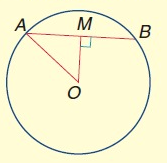
OM ⊥ AB. AO = 5 cm, OM = 4 cm. Find the length of AM and AB.
Solution:
By using Pythagorean Theorem,
OA2 = OM2 + AM2
52 = 42 + AM2
25 = 16 + AM2
AM2 = 25 - 16
AM2 = 9
AM = 3 cm
AB = 2 × AM
= 2 × 3
AB = 6 cm
So, length of chord AB is 6 cm.
Problem 2 :
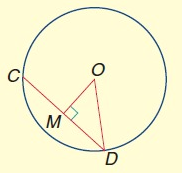
OM ⊥ CD. MO = 6 m, OD = 8 m. Find the length of MD and CD.
Solution:
By using Pythagorean Theorem,
OD2 = OM2 + MD2
82 = 62 + MD2
64 = 36 + MD2
MD2 = 64 - 36
MD2 = 28
MD = 5.3 m
CD = 2 × MD
= 2 × 5.3
CD = 10.6 m
So, the length of chord CD is 10.6 m.
Problem 3 :
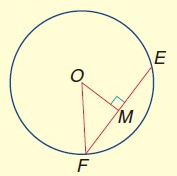
OM ⊥ EF. OM = 12 mm, OF = 13 mm. Find the length of FM and FE.
Solution:
By using Pythagorean Theorem,
OF2 = OM2 + FM2
132 = 122 + FM2
169 = 144 + FM2
FM2 = 169 - 144
FM2 = 25
FM = 5 mm
FE = 2 × FM
= 2 × 5
FE = 10 mm
Length of FM is 5 mm and length of FE is 10 mm.
Problem 4 :
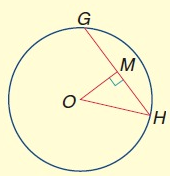
OM ⊥ GH. MH = 8 cm, OM = 6 cm. Find the length of OH and GH.
Solution:
By using Pythagorean Theorem,
OH2 = OM2 + MH2
OH2 = 62 + 82
OH2 = 36 + 64
OH2 = 100
OH = √100
OH = 10 cm
GH = 2 × MH
= 2 × 8
GH = 16 cm
So, length of OH is 10 cm and GH is 16 cm.
Problem 5 :
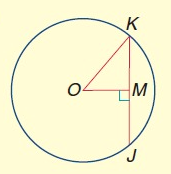
OM ⊥ JK. KJ = 14 cm, OM = 3 m. Find the length of KM and OK.
Solution:
KJ = 14 cm = 0.14 m
By using Pythagorean Theorem,
OK2 = OM2 + KM2
OK2 = 32 + (0.07)2
OK2 = 9 + 0.0049
= 9.0049
OK = √9.0049
OK = 3 m
KM = 0.07 m
So, length of KM is 0.07 m and OK is 3 m.
Problem 6 :
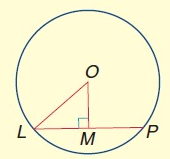
OM ⊥ LP. OL = 10 m, LP = 18 mm. Find the length of LM and OM.
Solution:
LP = 18 mm = 0.018 m
By using Pythagorean Theorem,
OL2 = OM2 + LM2
102 = OM2 + (0.0019)2
100 = OM2 + 0.000081
OM2 = 99.9
OM = √99.9
OM = 9.9 m
LM = 0.0019 m
Subscribe to our ▶️ YouTube channel 🔴 for the latest videos, updates, and tips.
Recent Articles
-
Finding Range of Values Inequality Problems
May 21, 24 08:51 PM
Finding Range of Values Inequality Problems -
Solving Two Step Inequality Word Problems
May 21, 24 08:51 AM
Solving Two Step Inequality Word Problems -
Exponential Function Context and Data Modeling
May 20, 24 10:45 PM
Exponential Function Context and Data Modeling